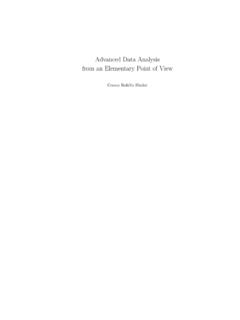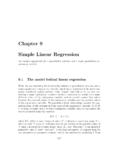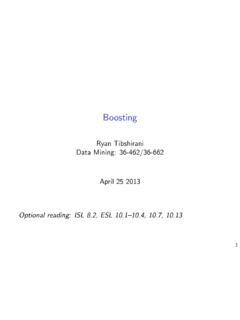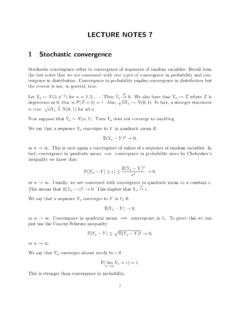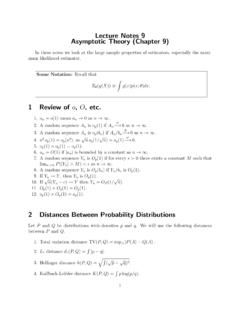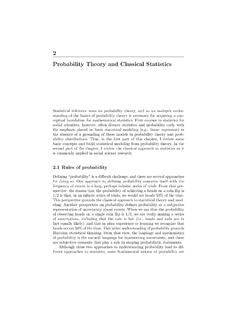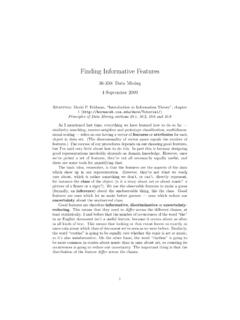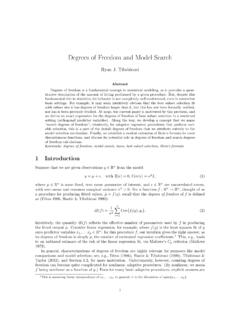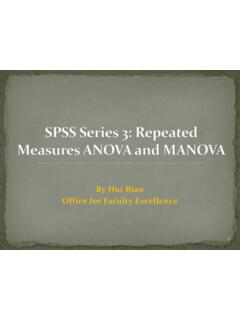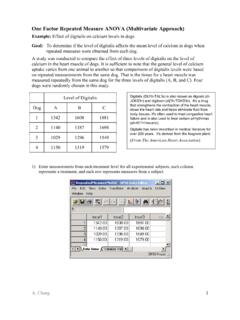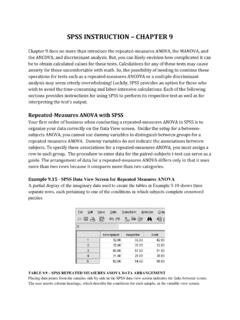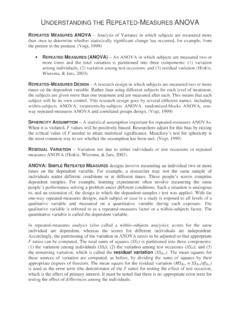Transcription of Chapter 14 Within-Subjects Designs - CMU Statistics
1 Chapter 14 Within-Subjects DesignsANOVA must be modified to take correlated errors into account when multiplemeasurements are made for each Overview of Within-Subjects designsAny categorical explanatory variable for which each subject experiences all of thelevels is called awithin-subjects factor. (Or sometimes a subject may experienceseveral, but not all levels.) These levels could be different treatments , or theymay be different measurements for the same treatment ( , height and weight asoutcomes for each subject ), or they may be repetitions of the same outcome overtime (or space) for each subject . In the broad sense, the termrepeated measureis a synonym for a within - subject factor, although often the term repeated measuresanalysis is used in a narrower sense to indicate the specific set of analyses discussedin Section contrast to a Within-Subjects factor, any factor for which each subject ex-periences only one of the levels is abetween-subjects factor.
2 Any experimentthat has at least one Within-Subjects factor is said to use awithin-subjects de-sign, while an experiment that uses only between-subjects factor(s) is called abetween-subjects design . Often the termmixed designormixed within -and between-subjects designis used when there is at least one within -subjectsfactor and at least one between-subjects factor in the same experiment. (Be care-ful to distinguish this from the so-called mixed models of Chapter 15.) All of the339340 Chapter 14. Within-Subjects Designs experiments discussed in the preceding chapters are between-subjects do not confuse the terms between-groups and within -groups with theterms between-subjects and Within-Subjects . The first two terms, which we firstencountered in the ANOVA Chapter , are names of specific SS and MS compo-nents and are named because of how we define the deviations that are summedand squared to compute SS.
3 In contrast, the terms between-subjects and Within-Subjects refer to experimental Designs that either do not or do make multiplemeasurements on each a Within-Subjects factor is used in an experiment, new methods areneeded that do not make the assumption of no correlation (or, somewhat morestrongly, independence) of errors for the multiple measurements made on the samesubject. (See section to review the independent errors assumption.)Why would we want to make multiple measurements on the same subjects?There are two basic reasons. First, our primary interest may be to study thechange of an outcome over time, , a learning effect. Second, studying multipleoutcomes for each subject allows each subject to be his or her own control , ,we can effectively remove subject -to- subject variation from our investigation of therelative effects of different treatments.
4 This reduced variability directly increasespower, often dramatically. We may use this increased power directly, or we mayuse it indirectly to allow a reduction in the number of subjects are very important advantages to using Within-Subjects Designs , and suchdesigns are widely used. The major reasons for not using Within-Subjects designsare when it is impossible to give multiple treatments to a single subject or becauseof concern about confounding. An example of a case where a within -subjectsdesign is impossible is a study of surgery vs. drug treatment for a disease; subjectsgenerally would receive one or the other treatment, not confounding problem of Within-Subjects Designs is an important the case of three kinds of hints for solving a logic problem.
5 Let s takethe time till solution as the outcome measure . If each subject first sees problem1 with hint 1, then problem 2 with hint 2, then problem 3 with hint 3, then wewill probably have two major difficulties. First, the effects of the hintscarry-overfrom each trial to the next. The truth is that problem 2 is solved when thesubject has been exposed to two hints, and problem 3 when the subject has beenexposed to all three hints. The effect of hint type (the main focus of inference) isconfoundedwith the cumulative effects of prior MULTIVARIATE DISTRIBUTIONS341 The carry-over effect is generally dealt with by allowing sufficient time betweentrials to wash out the effects of previous trials. That is often quite effective, ,when the treatments are drugs, and we can wait until the previous drug leaves thesystem before studying the next drug.
6 But in cases such as the hint study, thisapproach may not be effective or may take too much other, partially overlapping, source of confounding is the fact that whentesting hint 2, the subject has already had practice with problem 1, and whentesting hint three she has already had practice with problems 1 and 2. This is thelearning learning effect can be dealt with effectively by carryover effect is also partially corrected by counterbalancing. Counterbal-ancing in this experiment could take the form of collecting subjects in groups ofsix, then randomizing the group to all possible orderings of the hints (123, 132,213, 231, 312, 321). Then, because each hint is evenly tested at all points along thelearning curve, any learning effects would balance out across the three hint types,removing the confounding.
7 (It would probably also be a good idea to randomizethe order of the problem presentation in this study.)You need to know how to distinguish Within-Subjects from between-subjects factors. Within-Subjects Designs have the advantages of morepower and allow observation of change over time. The main disadvan-tage is possible confounding, which can often be overcome by Multivariate distributionsSome of the analyses in this Chapter require you to think aboutmultivariatedistributions. Up to this point, we have dealt with outcomes that, among allsubjects that have the same given combination of explanatory variables, are as-sumed to follow the (univariate) Normal distribution. The mean and variance,along with the standard bell-shape characterize the kinds of outcome values thatwe expect to see.
8 Switching from the population to the sample, we can put thevalue of the outcome on the x-axis of a plot and the relative frequency of that342 Chapter 14. Within-Subjects Designs value on the y-axis to get a histogram that shows which values are most likely andfrom which we can visualize how likely a range of values represent the outcomes of two treatments for each subject , we need a so-called, bivariate distribution. To produce a graphical representation of a bivariatedistribution, we use the two axes (say, y1 and y2) on a sheet of paper for the twodifferent outcome values, and therefore each pair of outcomes corresponds to apoint on the paper with y1 equal to the first outcome and y2 equal to the secondoutcome. Then the third dimension (coming up out of the paper) represents howlikely each combination of outcome is.
9 For a bivariate Normal distribution, this islike a real bell sitting on the paper (rather than the silhouette of a bell that wehave been using so far).Using an analogy between a bivariate distribution and a mountain peak, we canrepresent a bivariate distribution in 2-dimensions using a figure corresponding to atopographic map. Figure shows the center and the contours of one particularbivariate Normal distribution. This distribution has a negative correlation betweenthe two values for each subject , so the distribution is more like a bell squished alonga diagonal line from the upper left to the lower right. If we have no correlationbetween the two values for each subject , we get a nice round bell. You can seethat an outcome likeY1= 2, Y2= 6 is fairly likely, while one likeY1= 6, Y2= 2is quite unlikely.
10 (By the way, bivariate distributions can have shapes other thanNormal.)The idea of the bivariate distribution can easily be extended to more than twodimensions, but is of course much harder to visualize. A multivariate distributionwith k-dimensions has a k-length vector (ordered set of numbers) representing itsmean. It also has ak kdimensional matrix (rectangular array of numbers) repre-senting the variances of the individual variables, and all of the paired covariances(see section ).For example a 3-dimensional multivariate distribution representing the out-comes of three treatments in a Within-Subjects experiment would be characterizedby a mean vector, , = 1 2 3 , MULTIVARIATE DISTRIBUTIONS343 Figure : Contours enclosing 1/3, 2/3 and 95% of a bivariate Normal distribu-tion with a negative a variance-covariance matrix, , = 21 1,2 1,3 1,2 22 2,3 1,3 2,3 23.
